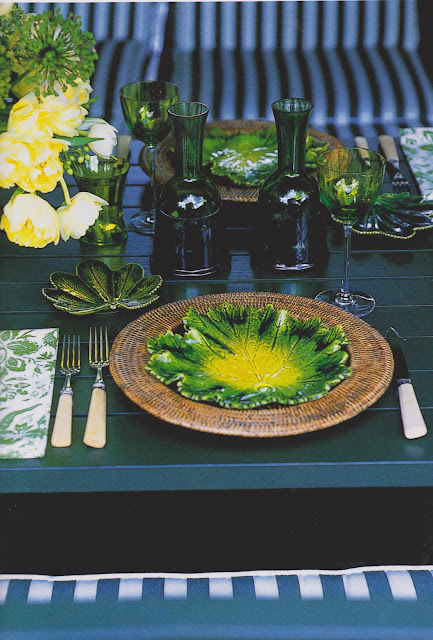Now that spring is here, it's time to fantasize about summer evenings and outdoor entertaining. Majolica earthenware, with its bright colors and naturalistic themes, is particularly suited for this time of year. This perennially popular form of pottery can be quite pricey in boutiques, particularly if one is in the market for the better quality Englishware, rather than contemporary Chinese imitations. Fortunately, one of the largest annual majolica auctions is coming up next month.
Majolica is an invention of the Victorians--who, of course, were imitating another country's famous wares, because that how it goes in pottery, if not art in general. In this specific instance: Mintons, the legendary English manufacturer, was inspired by artistic efforts stemming from two different parts of Europe. The first was Italian maiolica, the colorful earthenware grounded by a white opaque glaze that remains popular. The second influence was a French potter named Bernard Palissy. Palissy had actually lived nearly two centuries before: 1510-1590, but his artistic creations, which he termed "rustique" due to the abundance of plants and animal forms, were enjoying a 19th century resurgence.
 |
| French Palissyware from the mid 1500s, tentatively attributed to Bernard Palissy |
Minton exhibited his Victorian majolica ware at the Exposition Universelle in Paris in 1855 and caused a sensation, with every single exhibited piece sold by the end of the show. Within a few years,Wedgwood was making majolica, and several other manufacturers followed suit: George Jones and Sons (Trent Pottery), Hanley and Furnival, to name a few. Several European manufacturers, including Choisy le Roi and Boch Freres became popular. Majolica was produced in the United States as well, perhaps the most famous manufacturer being Griffin, Smith and Hill of Pennsylvania, which made Etruscanware from 1880-1890.
By the time Queen Victoria died in 1901, majolica had fallen out of favor, with the trend moving toward more streamlined Art Nouveau pieces. But everything old is new again. Majolica is a popular collectible today, as is Palissyware. The 16th century Palissy pieces are out of reach for most of us, of course; look instead for Victorian versions and Portuguese Palissy--still expensive--or even well-crafted contemporary versions. The first place I'd look? The Strawser Auction House (famous for its collectible auctions) is having a two day majolica auction on April 13th and 14th. But I'm warning you: the biggest challenge is deciding what to bid on! Good luck...happy bidding...and most of all happy spring!
 |
In A Passion for Flowers , Carolyne Roehm writes that she has collected majolica for years. , Carolyne Roehm writes that she has collected majolica for years.
Part of her collection appears above. Get an instant collection --or a ton of birthday presents with one stroke of the hammer--below. |
 |
Majolica is particularly well suited for bright summer blooms. Dalias, zinnas and Carolyne Roehm's majolica collection, from A Passion for Flowers . .
| |  | |
|
|
|
|
|
|
|
|
|
|
|
|
|
|
|
|
|
Bright glossy green, with all its vegetal associations, is one of the most frequent and popular hues in majolicaware. Charles Faudree, the self-proclaimed "King of Tablescapes," adds a green touch to a table, above, and surrounding a mirror, below. From
Details.
 |
| The family room of Lauren King's Hollywood mansion features a collection of Palissy ware. From Architectural Digest . |





















No comments:
Post a Comment